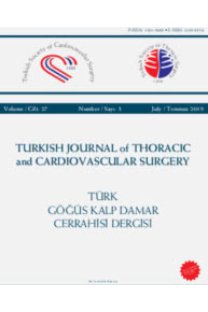Is physiotherapy effective on the occurrence of postoperative pulmonary complications in patients undergoing coronary artery bypass graft surgery? A randomized controlled trial
Koroner arter baypas greft cerrahisi yapılan hastalarda ameliyat sonrası pulmoner komplikasyon gelişiminde fizyoterapi etkili midir? Randomize kontrollü çalışma
___
- 1. Roosens C, Heerman J, De Somer F, Caes F, Van Belleghem Y, Poelaert JI. Effects of off-pump coronary surgery on the mechanics of the respiratory system, lung, and chest wall: Comparison with extracorporeal circulation. Crit Care Med 2002;30:2430-7.
- 2. Staton GW, Williams WH, Mahoney EM, Hu J, Chu H, Duke PG, et al. Pulmonary outcomes of off-pump vs on-pump coronary artery bypass surgery in a randomized trial. Chest 2005;127:892-901.
- 3. Hulzebos EH, Van Meeteren NL, De Bie RA, Dagnelie PC, Helders PJ. Prediction of postoperative pulmonary complications on the basis of preoperative risk factors in patients who had undergone coronary artery bypass graft surgery. Phys Ther 2003;83:8-16.
- 4. Pasquina P, Tramèr MR, Walder B. Prophylactic respiratory physiotherapy after cardiac surgery: systematic review. BMJ 2003;327:1379.
- 5. The Society of Thoracic Surgeons. Definitions of terms of the society of thoracic surgeons national cardiac surgery database. Ann Thorac Surg 1994;58:271-3.
- 6. Fındık O, Haberal İ, Akyıldız M, Aksoy T, Ertürk E, Zorman Y, et al. EuroSCORE, Cleveland ve CABDEAL klinik risk sınıflama sistemlerinin Türk toplumu için duyarlılık ve özgüllüklerinin karşılaştırılması. Turk Gogus Kalp Dama 2012;20:458-66.
- 7. Hulzebos EH, Helders PJ, Favié NJ, De Bie RA, Brutel de la Riviere A, Van Meeteren NL. Preoperative intensive inspiratory muscle training to prevent postoperative pulmonary complications in high-risk patients undergoing CABG surgery: a randomized clinical trial. JAMA 2006;296:1851-7.
- 8. Kroenke K, Lawrence VA, Theroux JF, Tuley MR. Operative risk in patients with severe obstructive pulmonary disease. Arch Intern Med 1992;152:967-71.
- 9. ATS Committee on Proficiency Standards for Clinical Pulmonary Function Laboratories. ATS statement: guidelines for the six-minute walk test. Am J Respir Crit Care Med 2002;166:111-7.
- 10. Aydemir Ö, Güvenir T, Küey L. Turkish version of hospital anxiety and depression scale. Turkish Psychiatry J 1997:280-7.
- 11. Pinar R. Reliability and construct validity of the SF-36 in Turkish cancer patients. Qual Life Res 2005;14:259-64.
- 12. Portney L, Watkins M. Foundations of Clinical Research: Applications to Practice: Norwalk, Connecticut: Appleton and Lange; 1993.
- 13. Renault JA, Costa-Val R, Rossetti MB. Respiratory physiotherapy in the pulmonary dysfunction after cardiac surgery. Rev Bras Cir Cardiovasc 2008;23:562-9.
- 14. Johnson D, Kelm C, To T, Hurst T, Naik C, Gulka I, et al. Postoperative physical therapy after coronary artery bypass surgery. Am J Respir Crit Care Med 1995;152:953-8.
- 15. Stiller K, Montarello J, Wallace M, Daff M, Grant R, Jenkins S, et al. Efficacy of breathing and coughing exercises in the prevention of pulmonary complications after coronary artery surgery. Chest 1994;105:741-7.
- 16. Jenkins SC, Soutar SA, Loukota JM, Johnson LC, Moxham J. Physiotherapy after coronary artery surgery: are breathing exercises necessary? Thorax 1989;44:634-9.
- 17. Dull JL, Dull WL. Are maximal inspiratory breathing exercises or incentive spirometry better than early mobilization after cardiopulmonary bypass? Phys Ther 1983;63:655-9.
- 18. Crowe JM, Bradley CA. The effectiveness of incentive spirometry with physical therapy for high-risk patients after coronary artery bypass surgery. Phys Ther 1997;77:260-8.
- 19. Herdy AH, Marcchi PL, Vila A, Tavares C, Collaço J, Niebauer J, et al. Pre- and postoperative cardiopulmonary rehabilitation in hospitalized patients undergoing coronary artery bypass surgery: a randomized controlled trial. Am J Phys Med Rehabil 2008;87:714-9.
- 20. Yánez-Brage I, Pita-Fernández S, Juffé-Stein A, Martínez- González U, Pértega-Díaz S, Mauleón-García A. Respiratory physiotherapy and incidence of pulmonary complications in off-pump coronary artery bypass graft surgery: an observational follow-up study. BMC Pulm Med 2009;9:36.
- 21. Valkenet K, de Heer F, Backx FJ, Trappenburg JC, Hulzebos EH, Kwant S, et al. Effect of inspiratory muscle training before cardiac surgery in routine care. Phys Ther 2013;93:611-9.
- 22. Verrill DE, Fox L, Moore JB, Miller J, Belles C, Barrier J, et al. Validity and reliability of the North Carolina 6-minute cycle test. J Cardiopulm Rehabil 2006;26:224-30.
- 23. Hirschhorn AD, Richards D, Mungovan SF, Morris NR, Adams L. Supervised moderate intensity exercise improves distance walked at hospital discharge following coronary artery bypass graft surgery--a randomised controlled trial. Heart Lung Circ 2008;17:129-38.
- 24. Baptista VC, Palhares LC, de Oliveira PP, Silveira Filho LM, Vilarinho KA, Severino ES, et al. Six-minute walk test as a tool for assessing the quality of life in patients undergoing coronary artery bypass grafting surgery. Rev Bras Cir Cardiovasc 2012;27:231-9.
- 25. Garbossa A, Maldaner E, Mortari DM, Biasi J, Leguisamo CP. Effects of physiotherapeutic instructions on anxiety of CABG patients. Rev Bras Cir Cardiovasc 2009;24:359-66.
- ISSN: 1301-5680
- Yayın Aralığı: 4
- Başlangıç: 1991
- Yayıncı: Bayçınar Tıbbi Yayıncılık
Paramedian retroperitoneal approach for revascularization of aortoiliac occlusive disease
Fırat DURNA, Serkan GİRGİN, Mohammed ALSHALALDEH, Bilgin EMRECAN
Kardiyak miksomalar ve cerrahi sonuçları
Eylem TUNÇER, Nihan KAYALAR, Kamil BOYACIOĞLU
Successful lung volume reduction surgery after coronary artery bypass grafting: a case report
Tuğra GENÇPINAR, Çağatay BİLEN, Kıvanç METİN, Ercan KELEŞ, Öztekin OTO
Açık kalp cerrahisinde doku oksijen satürasyonu takibi ile mikro dolaşımın değerlendirilmesi
Hasan KARABULUT, Murat ÖKTEN, Cem ARITÜRK, Uğur AKSU, Fevzi TORAMAN, Halim ULUGÖL, Jülide KART SAYIN
Bronş stapler hattında kesilmiş bronşiyal bloker ucu: Beklenmedik bir komplikasyon
Mine SOLAK, Salih TOPÇU, Yavuz GÜRKAN, Tülay HOŞTEN, Alparslan KUŞ
Hamit Serdar BAŞBUĞ, Sefer USTA, Yavuz ÇAKIROĞLU, Mehmet Halil ÖZTÜRK
Survival in adenosquamous cancer of the lung: is it really so unfavorable?
Tunç LAÇİN, İrfan YALÇINKAYA, Mustafa VAYVADA, Talha DOĞRUYOL, Serdar EVMAN, Levent ALPAY, Hakan KIRAL, Volkan BAYSUNGUR
Mert DUMANTEPE, Osman FAZLIOĞULLARI, Süha KÜÇÜKAKSU, Mustafa SEREN
Pulmoner arterin cerrahi gerektiren edinsel hastalıkları
Gül Deniz YILMAZ YELVAR, Yasemin ÇIRAK, Zehra KARAHAN, İlknur ERDEN, Ufuk DEMİRKILIÇ
